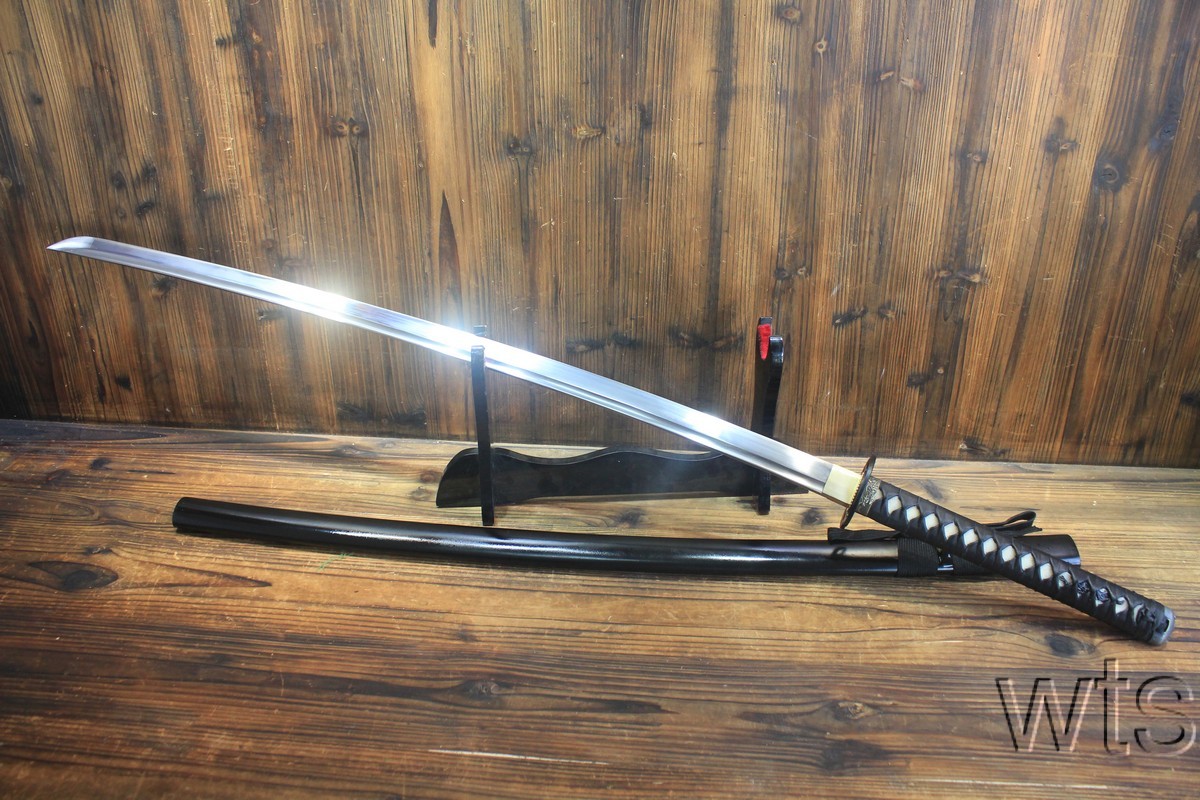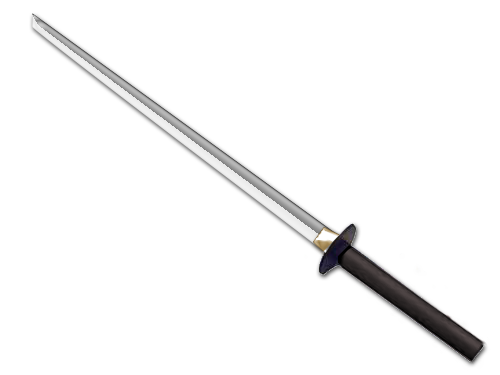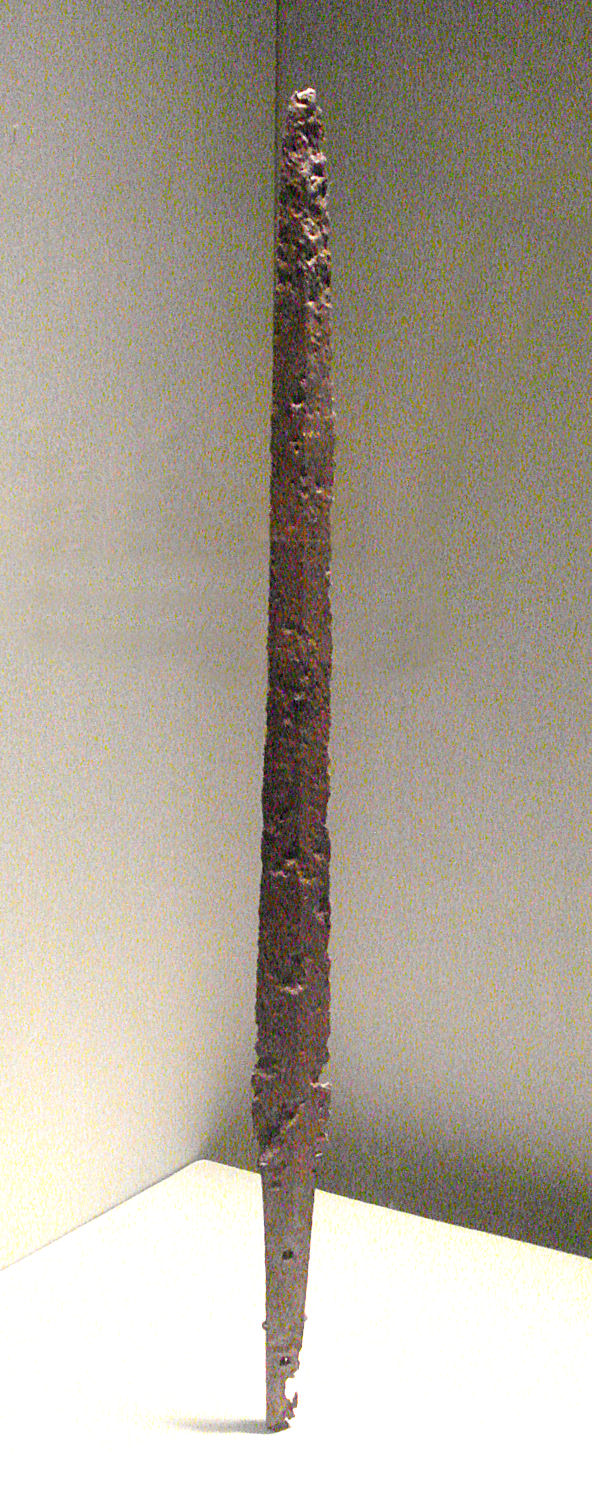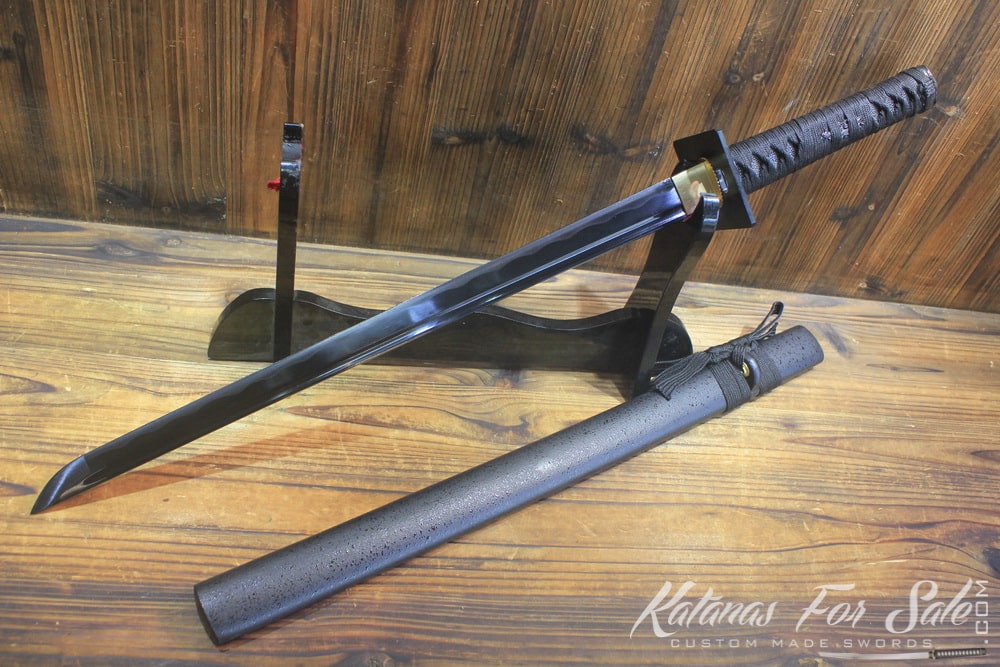
Japanese swords were the privilege of only the most skilled and honoured Japanese warriors. Not everyone had the chance to handle a samurai sword. Those who did were honourable personalities with immense fighting skills and a premium reputation as a fighter.
The primary role of these Japanese swords was for fighting, although they go beyond just being military swords. They are works of art, created and crafted by only the most skilful craftsmen and swordsmiths. Even today, Japanese swords are produced by craftsmen with decades of experience and expertise when it comes to samurai swords.
Almost everyone knows about the katana, but there are many more types of Japanese swords. There’s the odachi sword, Tachi sword, ninja sword, and a whole host of other models that not many people know of.

In this article, I’ve gathered together 20 types of Japanese swords that are not as known to the general public. These are real pieces of art, but at their core, they are fighting swords (most of them) with a unique design – something we simply don’t see in the West.
Not two types of Japanese swords are the same – they vary in shape, size, type of handle, grain structure, building materials, and the grain tempered on the edge of the sword.
Sit back and relax. Observe the beauty of the variety that comes with Japanese swords.
1. Odachi

Odachi, or Nodachi sword, as it’s sometimes called, was a samurai sword that was one of the more traditional swords used by the samurais on a battlefield.
The odachi sword is a big, two-handed sword that was mainly used against cavalry in open-field battles. As they were too big to be sheathed on one’s waist, they were either sheathed on one’s back, or they were carried in hand or held by a helper.
The word odachi, or Nodachi, translates to the “great sword”, and is an equivalent to the longsword from the West. However, the production of these samurai blades was much more complex. Due to their length (90cm, or 35.8 inches), the regular heat treatment was harder due to the length of the blade. And because the blade was curved, it required a skilled swordsmith to produce an odachi sword.
If you would like to read more about Odachi Sword, click here.
2. Tachi

The Tachi sword was a predecessor to the katana, one of the most famous Japanese sword. They share many similarities, although there are some vital differences between the two.
Firstly, a Tachi sword is longer and curvier. Authentic Tachi swords stem from the Koto period (from 900-1596). After that, katanas started becoming more prevalent. These two types of blades were separated from each other by the signature on the tang.
The production of the blade was a complicated one. It had to be made in a set amount of time and from the correct materials. It also had to follow specific instructions as to how the blade should look. Namely, a Tachi sword had a blade of around 70-80 cm (27-31 inches), was longer than a katana, had a bigger curve, and was also thinner.
3. Katana

When we think of Japanese swords, most of us think of a katana sword. That’s because they are historically and traditionally one of the most common swords used by the samurais. And katanas only became a popular choice during the Shinto period (1596-1780), although they were already in use earlier.
A katana was meant to be held by two hands and were a popular choice for close combat. Usually, they were smaller than the Tachi swords, although they were still quite substantial. They were about 60-70 cm (27-28 inches) in size. The blades were curved, although not as much as the Tachi blades.
Traditional katanas were slightly different from modern katanas. They were larger, longer, and more substantial. And katanas held up all the way until today. During WW2, they were a preferred weapon of choice of the fighters. For a brief period after WW2, katanas were banned, although they began to be produced after 1953 again.
Katanas are made from Japanese steel called Tamahagane, which is folded several times to create a sturdy blade. The older the steel is, the better the blade will be, but it will also cost more. But it’s the curving procedure that makes a katana a marvel.
You Can Check Our Popular articles about Katana Here
4. Wakizashi

The wakizashi sword was a sword that complemented the katana, or another longer sword. Many warriors carried the wakizashi sword in addition to the katana, as it was a more lightweight, shorter sword that could be wielded by just one arm.
Wakizashi swords are between 30-60cm (12-24 inches) in size – the average size of the sword is about 50cm. The pairing of a katana and a wakizashi sword was called Daisho – translating roughly to “big-little”. However, we must not think of this type of sword as just the smaller version of a katana.
They usually had very specific and unique production processes. They were slightly thicker than katanas, and if the production was unique, it was also slightly less curved. Many of these swords also had unique patterns on the edge of the sword.
5. Shin Gunto

The shin Gunto sword was a part of the Gunto sword family. The word shin Gunto translates to “new military sword”, and they were mainly used by the Imperial Japanese Army between 1935 and 1945. It was to complement the usual weapons that were used during WW2, such as guns and pistols.
These swords were styled after the original Gunto swords from the 12th and 13th centuries. They were only worn by officers, who used to wear this sword according to their status in the military. Generals wore brown-red and gold shin Gunto, while officers mainly wore brown or brown-red swords.
Various subtypes of the shin Gunto were produced over the years. The Type 94 Shin Gunto were the first models from 1934, although the Type 95 swords were produced already the next year. Type 98 Shin Gunto swords started production in 1938. These Japanese swords were often seen with Japanese troops, especially generals, during WW2.
6. Tanto
The tanto swords were used by Japanese samurais when the combat went close and personal. These swords were double-edged short swords – usually, the size of these blades was between 15-30cm (6-12 inches). They were made before the new tactical knives were designed after WW2. And we can still see tanto swords today.
The primary role of a tanto was for self-defense. They were much like knives, although they were far more complex to make than regular knives. There are 12 different blades that can be mounted on the tanto sword. Since the 10th century, tanto swords were one of the primary swords that samurais used for personal self-defense, and for when combat became intense, close-quarters.
7. Ninja

Ninja swords were swords that were used by shinobi, or ninjas. Ninjas were covert agents of medieval Japan, and they became somewhat of a cult figure in Japan. They even had their own blades.
Ninja swords were relatively different from katanas. Firstly, they had straight blades, and they were also slightly shorter. The length of ninja swords was about 48cm (19 inches). They were thick and made for unusual forms of combat. Additionally, they were not as complicated to create as katanas, for example, as they had straight blades without curves.
The main purpose of a ninja sword was for stabbing, unlike curved blades which were made to cut instead of stab. And they were also smaller because ninjas were also more agile, as they often climbed and moved around swiftly, so the sword had to be inconspicuous.
8. Uchigatana

Uchigatana was the descendant of a Tachi sword. They started to be produced between the 14th and 16th centuries, and they were mainly used by samurais. The sizes of the blades varied between 60 and 70cm (from 24 inches), and the primary strategy to use these swords was to produce swift, cutting strikes.
These strikes were to be smooth, and just one swing was enough to do substantial damage. That’s slightly different from Tachi swords, which were to be used continually. As it was thin, it could be used single-handedly, and they were also more lightweight.
9. Tsurugi

The Tsurugi swords were something of a mythological blade. In Japanese mythology, Tsurugi blades were used as the “sword of the gods”, however, they were started to be produced during the Edo period. These swords were large, two-handed swords that were only used by imperial classes.
A Tsurugi sword was a large, long sword ranging in sizes between 90 to 100cm (35-39 inches); the handle itself was 8 inches long. It was also not usually curved – instead, it had a straight blade, made for big, striking blows. According to legends, the first Tsurugi blades were made from stone, although they were later made from bronze and iron.
In many ways, Tsurugi swords were similar to the Chinese Jian sword, which was a long broadsword.
10. Chokuto
Chokuto swords were ancient swords, made until the 9th century. They were one-edged swords with a straight blade. The primary role of Chokuto swords was for stabbing, and they were used by foot soldiers who wore these swords on their waists.

These swords are among the earliest swords from Japanese history. Some sources track it back to some of the Chinese swords from the time, although other sources say that it was developed independently. The main difference, however, was in the tempering – in the Japanese swordsmith industry, the tempering was durable and more sturdy.
11. Kodachi
Kodachi literally translates to “Little Tachi”, or “Small Tachi”. They were made in the style of Tachi swords, although they were much shorter. Usually, they would not exceed the size of 60cm (23 inches). Kodachi swords complemented the katana sword, but they are not to be confused with the wakizashi sword.
The primary role of the wakizashi was to complement the katana, but kodachi swords could still be used on their own. It’s stuck somewhere in between a dagger and a sword, although they were considered primary short swords.
In many ways, they resemble short swords that come from the West, although the styling was very different, including the curve of the sword, and its primary use.
12. Ninjato

The Ninjato was a ninja sword, although it was slightly longer than the usual ninja swords. They were straight blade swords, and they were used for stabbing primarily. Shinobis, or ninjas, used these swords for their covert operations.
An interesting fact is that samurai classes considered the activities of a ninja as something that’s below them. That’s why they had a relatively poor opinion of the Ninjato sword, and they almost never used one.
Ninja swords are a very popular occurrence nowadays. We can see these swords practically everywhere, especially in popular culture. Movies and anime often show Ninjato swords as these deadly weapons, although there is still a common misconception that ninjas used curved blades. Shinobis usually used Ninjato, which were straight blades, and very different from katanas.
13. Nagamaki

The Nagamaki sword was one of the traditional Japanese swords used by samurais. The unique feature of the Nagamaki sword was the extra-long handle which was usually as long as the blade itself. This made it perfect for two-handed usage where the right hand was always closer to the blade than the left. It was a sword that was commonly used against cavalry.
A usual Nagamaki was usually 54 inches long, where the handle was as long as the blade. This means that the handle is about 26-27 inches, while the blade itself is 25-27 inches long. The main, distinct feature of this blade is its handle.
In many ways, it was similar to a katana’s handle, although far sturdier and usually decorated with colors. Brown and red were a common occurrence.
14. Zanbato
Zanbato swords stem all the way back to the 3rd century BC. They are originally based on Chinese Zhanmadao swords, which were anti-cavalry swords. And Zanbato swords were made for specifically this usage – against cavalries.
The literal translation of Zanbato is “horse-slaying sword”, or “horse-chopping saber”. These swords are a rare find nowadays, although they are a very popular figure in many modern interpretations, such as anime and manga.
They loosely resemble a Nagamaki sword, although there were some distinct features that made the Zanbato sword unique. The handle was quite long – about 15 inches, and the blade was usually thicker and larger than with most blades. That made it a sword for cutting horses.
15. Daisho
Daisho represents a combination of two different swords being used simultaneously. Samurais often used or carried two different swords: in addition to a katana or daito (long sword), they also carried a shoto (short sword), such as a wakizashi. And this combination proved to be a deadly one, as samurais constantly interchanged between the two swords.
But these swords were not just two random swords used in combination. These two swords were carefully chosen by the samurai, and they were usually crafted by the same swordsmith. This means that these two swords had a matched set of fittings, and they were relatively similar in appearance.
A samurai would carry the long sword on his back or in his hands, while he would have the short sword around his waist. Daisho became popular during the Muromachi period (14th and 15th century), when samurais started acknowledging that long swords were not appropriate for close-quarters combat, and they needed a smaller, shorter blade to allow them to win a battle in close quarters.
16. Yoroi-Doshi
A Yoroi-Doshi was a type of tanto (knife) that was used specifically for piercing through armour.
The direct translation of Yoroi-Doshi is “armour piercer”, which tells us about the capability of this sword to shred through armour, even a thicker one.
These were short swords, or knives – they ranged in sizes between 20cm to 22cm, although some swords could be as short as 15cm (6 inches). The Yoroi-Doshi were very sharp and they had a very pointy end, allowing it to go through armour and injure the opponent with just a stab. It has a thick blade, which made it especially effective against thicker armours.

This blade started growing in popularity during the Sengoku period (14th and 15th centuries) when the first chainmail and steel armours were being introduced. Yoroi-Doshi was usually worn inside the belt on the back or on one’s waist, which allowed the samurais to wield the sword quickly and protect themselves from armoured opponents.
17. Kaiken

The Kaiken sword, or the knife, was a very small blade that was primarily used for self-protection in very closed areas, where the usual katanas and wakizashi swords were inconvenient. But, in addition to that, the Kaiken was a bit of a status symbol – only the highest classes were allowed to own one.
They were carried by both men and women, and they were tucked into the pocket of a kimono. Women only started to carry a Kaiken with them when they married as a means of self-protection. An interesting fact about the Kaiken knives is that they were often used for ritual suicide by cutting one’s neck veins.
The Kaiken blades were very small. Usually, they did not reach a size of 30 cm, and they were somewhere between 20-25 cm long (8-10 inches) long. There was plenty of space for customizability of Kaiken – the higher echelons of Japanese culture were allowed to have their own colors and distinct features that made the Kaiken unique.
18. Bokken

Bokken swords were primarily used as practice swords, or even as decorative pieces. They were wooden swords, so they were not used in combat. However, they were mostly a tool that samurais used for practice. Normally, they were katana-shaped, although many bokken swords were also smaller, such as wakizashi blades.
The size of a bokken depended on the type of training that a samurai required. If they wanted to practice close-quarter combat, they used smaller bokken swords. If they wanted some katana practice, they chose a katana-shaped bokken. And one of the primary uses of a bokken blade was also for teaching younger samurais to properly handle the sword.
Today, we still see a bokken in aikido or other martial arts where it acts as a practice weapon. Injuries can still happen, although these swords are made to simulate the usage of a katana without significant injuries.
19. Shinai

Shinai is another practice blade, used primarily in kendo. Today, shinai swords are used for competition in kendo, and they are also often used for practice. They are made from bamboo. The first practice swords from bamboo were made in the 16th century when they wanted to simulate real-life combat without harming.
Injuries still occurred, which is why the design of a shinai sword changed so much throughout the years. Smoked bamboo is commonly used, or a sort of bamboo that’s soaked in resin. It’s made of several components: the tsuka (handle), tsuba (collar), take, Naka-Yui, and Mono-Uchi. Today, plastic is often used for the handle and some parts, although the majority is still made from bamboo.
Shinai swords should be maintained frequently. This includes regular inspections for tears, fractures, and regular oiling. All this can extend the lifetime of the sword. Additionally, it can prevent injuries and the need to create or buy new shinai swords.
20. Kyu-Gunto

We’ve already talked about the Shin-Gunto, which was also called the “new military sword”. Kyu-Gunto, on the other hand, is also called the “old military sword”. It was the first standard sword used by the Japanese military. The first general that instructed the use of Kyu-Gunto was Murata Tsuneyoshi from the 19th century.
At first, these swords were made to represent the usual samurai swords, although they were still very much different. After a while, these old military swords started to look more and more like the European and American military swords. Today, they make an excellent collection of anyone’s ancient sword repertoire.
Because they were mass-produced, they lost a bit on the quality of the samurai swords. However, that changed in 1935, when Kyu-Gunto swords went out of fashion and Shin-Gunto swords were the standard sword for the military. Since then, Kyu-Gunto swords represent a valuable piece of antique.
